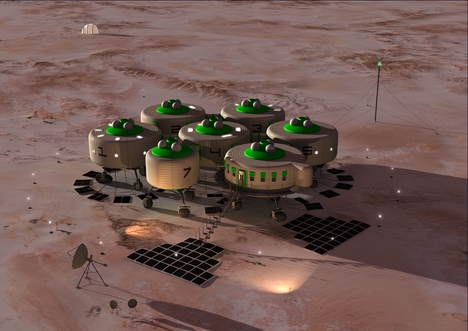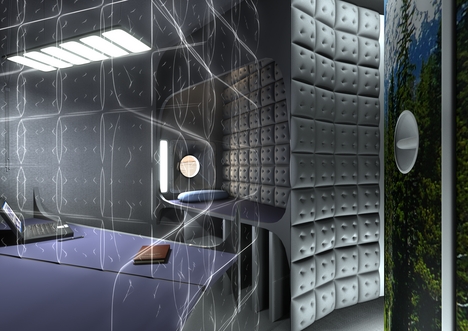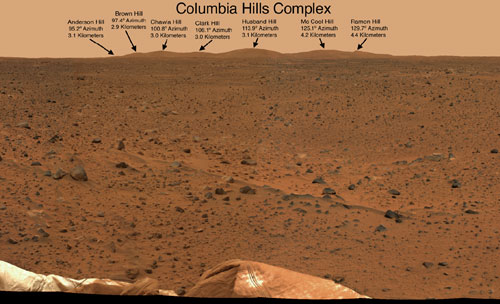Mars Bungalow and the Prison of Simulation
 [Image: ANY Design Studios, via Building Design].
[Image: ANY Design Studios, via Building Design].Following a few links from the perennially great things magazine, I discovered this new attempt at a future Martian architecture.
Meant to house "visitors," we read, at the Martian north pole, "ANY Design Studios has designed a robot on legs built of Martian ice." It comes complete with padded walls and a nice little bed.
Note, however, that the walls (on the right) have been painted to look like the Pacific northwest: even on Mars, we will live within simulations.
 [Image: ANY Design Studios, via Building Design].
[Image: ANY Design Studios, via Building Design]."What would it be like to spend nearly two Earth years at the Martian north pole," we're asked, "a place where darkness falls for nine months of the year, carbon dioxide snow flutters down in winter and temperatures drop to a chilly minus 150 centigrade?" I, for one, think it would be wonderful.
 [Image: ANY Design Studios, via Building Design].
[Image: ANY Design Studios, via Building Design].The architecture itself is "a self assembling six module robotic design on tracked landing legs." It's thus a cluster of smaller buildings that, together, "would allow for ten people to live indefinitely at the pole."
The architects behind the project go on to explain that they "have also been exploring the possibility of reproducing programmable Earth environments in a room we have called the ‘Multi Environment Chamber’. Settlers on Mars may well be able to make themselves a cup of tea and settle into a chair with the sun gently warming their skin, cool breezes, and the sound of songbirds of an English orchard on a warm July afternoon" – assuming that such an experience wasn't precisely what you were trying to get away from in the first place.
These "programmable Earth environments," though, should undoubtedly include a setting in which you are sitting in a room in southern California, which has been kitted out to look like a Martian base – inside of which a man sits, reminiscing about a room in southern California that he once decorated to look like a Martian bungalow... Which would be referred to as the interplanetary architecture of et cetera, et cetera, et cetera.
Phrased otherwise, of course, all of this would simply be an inversion of what William L. Fox describes in his recent book, Driving to Mars. There, Fox writes about "the idea of practicing Mars on Earth" – which means simply that, even as I write this, there are teams of astronauts on a remote base in northern Canada, acting as if they are already surrounded by Martian topography.
It's a form of psychological training: act as if you have already arrived.
So you simply turn that around and find, here, that anyone living inside this "self assembling six module robotic design on tracked landing legs" will really be "practicing Earth on Mars."
Act as if you never left.
But why not practice, say, Jupiter, instead? Why not be even more ambitious and use each planet in this solar system as a base from which to simulate the rest?
Or you could just abandon simulation altogether, of course, and experience Mars as Mars.

It's interesting, though, in this context, to look at the naming practices used by NASA through which they claim – or at least label – Martian territory. Landscapes on Earth toponymically reappear on the Martian plains; there is Bonneville Crater and Victoria Crater, for instance; there is Cape Verde and a cute little rock called "Puffin."
Mars is an alien landscape, then, in everything but name.
Even more fascinating, at least for me, is the small range of Martian hills now "dedicated to the final crew of Space Shuttle Columbia." Accordingly, these hills now appear on maps as the Columbia Hills Complex. An entire landscape named after dead American astronauts? Surely there's a J.G. Ballard story about something exactly like this?
Then again, according to one reviewer: "A story by J.G. Ballard, as you know, calls for people who don't think." Uh oh.
(Note: For more on Martian architecture don't miss the unbelievably weird proposal behind Mars Power!, discussed earlier on BLDGBLOG).





Comments are moderated.
If it's not spam, it will appear here shortly!
Hi
I think we need to think about planting a few trees or cacti on Mars before we can consider architectural grand designs for the place. Mars already has iced water which could be melted with solar energy. Think in little steps. Giant leaps lead to the abyss.
Regards,
Coral
Perhaps the wall panles could be programed to cycly through images inspired by great martian themed stories. Creating a Mars of Mars(s). A wholey self referential world containing its own histroyies and futures.
Keep up the great work
Alex
Geoff, have you read Kim Stanley Robinson's Red Mars? I think you might like it.
yeah, it's a surprise there isn't a "planets" theme park - the epcot centre being a pale representation of the jetsons - all persons entering having to don spacesuits and eat while standing on their head.. and of course, the crown jewel could be the "jupiter, and beyond the infinite" section... possible name: Beyond the Infinite Simulacra...
have U read Philip Jose Farmer's "Jesus on Mars" - exactly what U expect from the title... and given this... I wonder if current Mars simulations are somewhat mis-guided in their current choice of location (Canada) and should be looking into some prime real estate in Jerusalem (or perhaps that should be Afghanistan?)
and lest we forget Capricorn 1...
This reminds me of the future scenaro idea, that humans - in our condition - end up forgetting about space travel and instead we wallow in our world of ever faster smart machines and ever stupider celebrities... the planetary simulations are absorbed into the collective fabric like linoleum or marzipan and become the ghostly domain of solitary fools and blethering madfolk...
Imagine if you could only see the world through a tiny pair of lenses which projected images onto tiny sensing fields which 'digitized' them and sent them via cable to a processor, where many levels of pre-analysis were performed before you could even 'experience' them. Now that would be scary.
I dont think its possible to be in darkness '9 months of the year'. ^ theoretically at the pole yes, although even then there will be long periods of twilight.
Of course are we talking earth months or martian months...
Sounds cool though.
P
I think we should all heed Elton's wise words here:
"Mars ain't no place to raise your kids,
in fact it's cold as hell".
Too true, Reg, too true.
This is an awesome blog! Your ideas are great!
The idea of Mars colonization is very interesting... I'd love to visit one day, or even live there!
Check out Renegade's BS
did you notice that your blog was a blog of note again last week?
Just seconding the recommendation of Robinson's RED MARS. Best Mars book ever?
Mars is an alien landscape, then, in everything but name.
Even more fascinating, at least for me, is the small range of Martian hills now "dedicated to the final crew of Space Shuttle Columbia." Accordingly, these hills now appear on maps as the Columbia Hills Complex.
But an entire landscape named after dead American astronauts?
Naming alien places with familiar names is just what people do. New Amsterdam, New York, New Jersey ... place names for rivers and mountains in the New World generally will tell you where the people who colonized the place came from.
Even their architecture - the Pilgrims first houses were knock-offs of the places they'd lived in England. Later generations adopted building styles more suited to the new terrain as they moved west.
We might expect the same on Mars. The first generation place names and architecture will be a reflection of the culture that produced them. Later generations will build 'Martian'.
I can't wait to see it.
Ray Bradbury's 'The Martian Chronicles' should be required reading for anyone who believes in colonizing Mars.
of course, we dont need to worry about messing up Mars as we have done Earth, since there is nothing interesting on Mars to begin with. Let the party begin!!!
Post a Comment